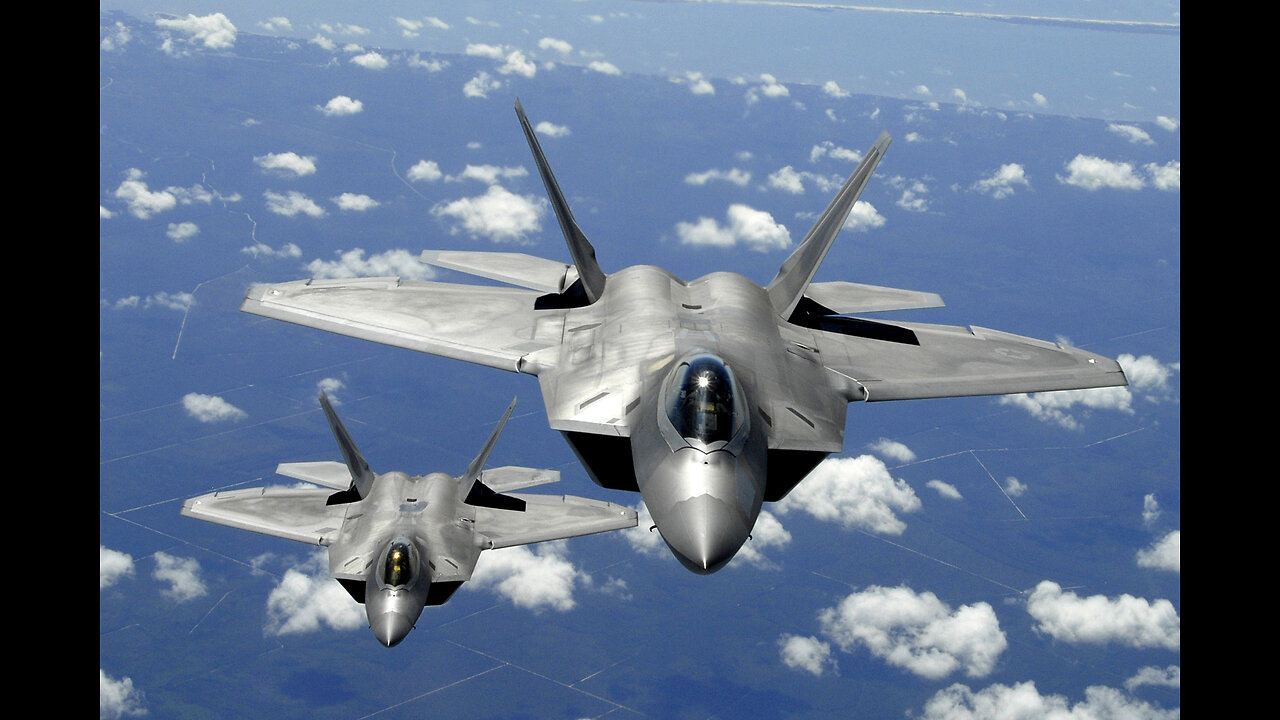Premium Only Content

F-22 Raptor - 5th Generation Stealth Tactical Fighter - USAF's ATF (Advanced Tactical Fighter)
F-22 Raptor - 5th Generation Stealth Tactical Fighter - USAF's ATF (Advanced Tactical Fighter)
The Lockheed Martin F-22 Raptor is an American single-seat, twin-engine, all-weather stealth tactical fighter aircraft developed for the United States Air Force (USAF). As the result of the USAF's Advanced Tactical Fighter (ATF) program, the aircraft was designed as an air superiority fighter, but also has ground attack, electronic warfare, and signals intelligence capabilities. The prime contractor, Lockheed Martin, built most of the F-22's airframe and weapons systems and conducted final assembly, while Boeing provided the wings, aft fuselage, avionics integration, and training systems.
Additional footage includes the story of the YF-23, the F-22 Raptor competitor and a video collection of some of the army's aircrafts and amphibious vehicles
The F-22 first flew in 1997 and was variously designated F-22 and F/A-22 before it formally entered service in December 2005 as the F-22A. Despite its protracted development and operational difficulties, USAF considers the F-22 a critical component of its tactical airpower. The fighter's combination of stealth, aerodynamic performance, and mission systems enable unprecedented air combat capabilities.
The USAF had originally planned to buy a total of 750 ATFs. In 2009, the program was cut to 187 operational aircraft due to high costs, a lack of air-to-air missions due to the focus on counterinsurgency operations at the time of production, a ban on exports, and development of the more affordable and versatile F-35, with the last F-22 delivered in 2012.
In 1981, the U.S. Air Force identified a requirement for an Advanced Tactical Fighter (ATF) to replace the F-15 Eagle and F-16 Fighting Falcon. Code-named "Senior Sky", this air-superiority fighter program was influenced by emerging worldwide threats, including new developments in Soviet air defense systems and the proliferation of the Sukhoi Su-27 "Flanker"- and Mikoyan MiG-29 "Fulcrum"-class of fighter aircraft. It would take advantage of the new technologies in fighter design on the horizon, including composite materials, lightweight alloys, advanced flight control systems and avionics, more powerful propulsion systems, and most importantly, stealth technology. In 1983, the ATF concept development team became the System Program Office (SPO) and managed the program at Wright-Patterson Air Force Base. The demonstration and validation (Dem/Val) request for proposals (RFP) was issued in September 1985, with requirements placing a strong emphasis on stealth and supercruise. Owing to the immense investments required to develop the technology needed to achieve performance goals, teaming between companies was encouraged. Of the seven bidding companies, Lockheed and Northrop were selected on 31 October 1986...
General characteristics
Crew: 1
Length: 62 ft 1 in (18.92 m)
Wingspan: 44 ft 6 in (13.56 m)
Height: 16 ft 8 in (5.08 m)
Wing area: 840 sq ft (78.04 m2)
Aspect ratio: 2.36
Airfoil: NACA 6 series airfoil
Empty weight: 43,340 lb (19,700 kg)
Gross weight: 64,840 lb (29,410 kg)
Max takeoff weight: 83,500 lb (38,000 kg)
Fuel capacity: 18,000 lb (8,200 kg) internally, or 26,000 lb (12,000 kg) with two 2× 600 US gal tanks
Powerplant: 2 × Pratt & Whitney F119-PW-100 augmented turbofans, 26,000 lbf (116 kN) thrust each dry, 35,000 lbf (156 kN) with afterburner
Performance
Maximum speed: Mach 2.25, 1,500 mph (2,414 km/h) at altitude
Mach 1.21, 800 knots (921 mph; 1,482 km/h) at sea level
Mach 1.82, 1,220 mph (1,963 km/h) supercruise at altitude
Range: 1,600 nmi (1,800 mi, 3,000 km) or more with 2 external fuel tanks
Combat range: 460 nmi (530 mi, 850 km) clean with 100 nmi (115 mi, 185 km) in supercruise
590 nmi (679 mi, 1,093 km) clean subsonic
Ferry range: 1,740 nmi (2,000 mi, 3,220 km)
Service ceiling: 65,000 ft (20,000 m)
g limits: +9.0/−3.0
Wing loading: 77.2 lb/sq ft (377 kg/m2)
Thrust/weight: 1.08 (1.25 with loaded weight and 50% internal fuel)
Armament
Guns: 1× 20 mm M61A2 Vulcan rotary cannon, 480 rounds
Internal weapons bays:
Air-to-air mission loadout:
6× AIM-120 AMRAAM
2× AIM-9 Sidewinder
Air-to-ground mission loadout:
2× 1,000 lb (450 kg) JDAM or 8× 250 lb (110 kg) GBU-39 Small Diameter Bombs
2× AIM-120 AMRAAM
2× AIM-9 Sidewinder
Hardpoint (external):
4× under-wing pylon stations can be fitted to carry weapons, each with a capacity of 5,000 lb (2,270 kg) or 600 U.S. gallon (2,270 L) drop tanks
4x AIM-120 AMRAAM (external)
Avionics
AN/APG-77 or AN/APG-77(V)1 radar: 125–150 miles (201–241 km) against 1 m2 (11 sq ft) targets (estimated range), more than 250 miles (400 km) in narrow beams
AN/AAR-56 Missile Launch Detector (MLD)
AN/ALR-94 electronic warfare system: 250 nautical miles (460 km) or more detection range for radar warning receiver (RWR)
Integrated CNI Avionics
MJU-39/40 flares for protection against IR missiles
-
 1:19:07
1:19:07
Joseph Wouk's Channel
20 days agoIsaac Newton - History’s Greatest Scientist
51 -
 18:25
18:25
Liberty Hangout
13 days agoAnti-Ice Demonstrators Love Poop!
18.6K44 -
 9:39
9:39
MattMorseTV
14 hours ago $0.89 earnedVance just DROPPED a BOMBSHELL.
30.5K61 -
 23:47
23:47
GritsGG
1 day agoThe Forgotten Best Sniper Support AR!
6.44K2 -
 1:15:48
1:15:48
The Pascal Show
16 hours ago $0.06 earnedMUGSHOTS RELEASED! Emmanuel Haro's Parents Mugshot Released To The Public
4.99K1 -
 14:45
14:45
BlabberingCollector
19 hours agoKings Cross Station SET LEAKS! | Harry Potter HBO Show Update & News
4.67K -
 33:20
33:20
SB Mowing
9 days agoHealth Struggles + Endless Rain = A Yard Out of Control
13.2K18 -
 1:09:42
1:09:42
Mike Rowe
4 days agoHow Did THIS Dirty Job Make Tommy Mello A Billionaire?! | #447 | The Way I Heard It
71.3K20 -
 10:11:30
10:11:30
SpartakusLIVE
11 hours agoThe BADDEST Duo in WZ Exhibits PEAK Physique || Duos w/ Sophiesnazz to start, quads later
170K1 -
 2:49:37
2:49:37
RattlesnakeTV
22 hours ago $0.28 earnedLIVE DEBATE! Lord Jake vs Crazy Feminist
31.4K18